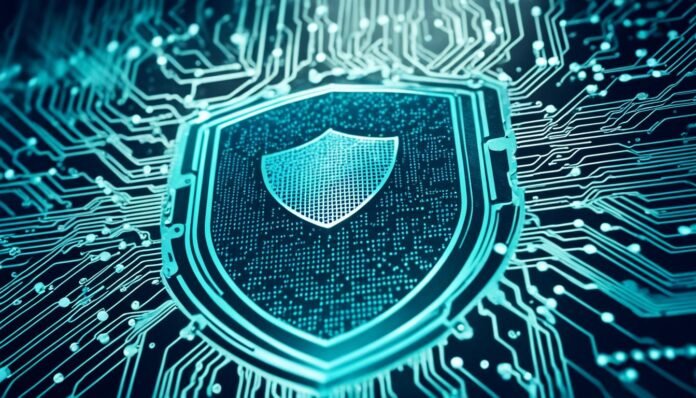In today’s digital world, cyber attacks are becoming increasingly prevalent, posing a significant threat to businesses of all sizes. With sensitive data at risk and cybercriminals constantly evolving their tactics, how can businesses ensure they are adequately protected?
Enter cyber liability insurance. But what exactly does it entail? How does cyber insurance coverage work, and what steps can businesses take to mitigate cyber risks?
In this article, we will explore the essentials of cyber liability insurance protection. We will delve into the various aspects of cyber insurance coverage, including data breach insurance, cyber risk management, cybersecurity insurance policy, internet liability insurance, and online data protection.
Join us as we uncover the key components necessary to safeguard your business against cyber threats and ensure comprehensive digital insurance coverage.
Key Takeaways:
- Cyber liability insurance provides essential protection against cyber attacks.
- Implementing security controls is crucial for cyber insurance coverage.
- Multi-factor authentication and cybersecurity training are key measures to mitigate cyber risks.
- Maintaining good data backups is essential for recovery from cyber incidents.
- Identity access management and additional security controls are required for favorable rates on cyber insurance policies.
Multi-Factor Authentication for Enhanced Security
In today’s digital landscape, protecting sensitive information from cyber threats is crucial. One effective security measure that businesses can implement is multi-factor authentication (MFA), also known as two-factor authentication (2FA). MFA adds an extra layer of security by requiring users to provide two or more credentials to access their accounts.
MFA works by validating the user’s identity with a second factor, in addition to their password. This second factor can be something they know, such as a personal identification number (PIN), or something they have, such as a one-time code sent to their mobile device or email. By requiring two or more factors, MFA significantly reduces the risk of unauthorized logins and provides enhanced protection against cyber incidents.
With the increasing prevalence of remote workforces, where employees can access company resources from anywhere, MFA becomes even more crucial. Remote work introduces additional vulnerabilities, as threat actors have more opportunities to attempt unauthorized logins. Implementing MFA ensures that even if an employee’s login credentials are compromised, an additional level of authentication is required to gain access to their account.
Moreover, MFA can limit the impact of cyber attacks like social engineering. Social engineering involves manipulating individuals to gain unauthorized access to systems or sensitive information. With MFA in place, threat actors attempting social engineering attacks would need an extra layer of authentication to successfully breach an account. This additional hurdle makes it much more challenging for them to gain unauthorized access.
“Multi-factor authentication adds an extra layer of security by requiring users to provide two or more credentials to access their accounts.”
Implementing MFA is a proactive approach that businesses can take to strengthen their cybersecurity defenses. By requiring multiple factors for authentication, MFA significantly reduces the risk of unauthorized logins and protects against cyber incidents. It is especially important for remote workforces and can help mitigate the impact of social engineering attacks. Businesses should consider implementing MFA as part of their overall cybersecurity strategy.
Benefits of Multi-Factor Authentication:
- Enhanced security by requiring additional credentials
- Reduced risk of unauthorized logins
- Protection against cyber incidents
- Added layer of defense for remote workforces
- Mitigation of the impact of social engineering attacks
Implementing MFA is a simple yet effective way to enhance security and protect against unauthorized access. By leveraging multiple factors for authentication, businesses can significantly reduce the risk of cyber incidents and safeguard their valuable data.
Cybersecurity Training for Employee Awareness
Cybersecurity training is a crucial and cost-effective method for protecting businesses against cyber threats. With the increasing number of data breaches caused by human error, it is essential to educate employees about the best practices for avoiding cyber attacks.
By providing regular cybersecurity training, businesses can empower their employees to identify and respond to potential threats effectively. Training sessions can cover topics such as:
- Recognizing phishing emails and avoiding clicking on malicious links
- Identifying social engineering attempts and tactics used by threat actors
- Implementing strong password policies and securing login credentials
- Following secure communication practices, including encryption and two-factor authentication
- Understanding the importance of software updates and patch management
- Reporting suspicious activities and incidents promptly
By raising awareness about these security practices, employees can play an active role in minimizing data breaches and protecting sensitive information.
“The human element is often the weakest link in cybersecurity defenses. By providing comprehensive training, businesses can significantly reduce the risk of breaches caused by human error.” – Cybersecurity Expert
Additionally, training sessions can include interactive exercises and simulations to simulate real-world cyber attack scenarios. This hands-on approach allows employees to practice their incident response skills and learn how to mitigate potential threats effectively.
The Benefits of Cybersecurity Training
Investing in cybersecurity training offers numerous benefits for businesses:
- Empowers employees: Training equips employees with the knowledge and skills to identify and respond to cyber threats, reducing the reliance on IT professionals and creating a culture of cybersecurity awareness.
- Minimizes human error: By educating employees about common attack vectors such as phishing emails and social engineering, businesses can significantly reduce the risk of accidental data breaches.
- Strengthens overall security: When employees understand the potential risks and adopt best practices, it enhances the organization’s overall security posture and minimizes vulnerabilities.
- Protects business reputation: Effective cybersecurity training ensures that employees understand the importance of safeguarding sensitive data, preserving customer trust, and protecting the company’s reputation.
- Meets compliance requirements: Many industries have specific cybersecurity training requirements to comply with regulations. Training employees helps businesses meet these obligations and avoid potential penalties.
Overall, cybersecurity training is a cost-effective method of improving the security awareness and resilience of businesses. By taking proactive measures to educate employees, organizations can mitigate the risks posed by cyber threats and protect their valuable assets.
| Key Benefits of Cybersecurity Training | Description |
|---|---|
| Empowers Employees | Equips employees with knowledge and skills to identify and respond to cyber threats. |
| Minimizes Human Error | Reduces the risk of accidental data breaches caused by human error. |
| Strengthens Overall Security | Enhances the organization’s security posture and minimizes vulnerabilities. |
| Protects Business Reputation | Safeguards sensitive data, preserving customer trust and protecting the company’s reputation. |
| Meets Compliance Requirements | Helps businesses meet cybersecurity training obligations required by industry regulations. |
Maintaining Good Data Backups
Good data backups are a critical component of a robust cybersecurity strategy, particularly when it comes to mitigating the risk of a complete loss in the event of a cyber attack. Having reliable data backups in place can be the key determinant between experiencing a full recovery or enduring significant consequences.
One of the most prevalent cyber threats that businesses face today is ransomware attacks. These malicious attacks can encrypt data and hold it hostage, demanding a ransom payment for its release. In such scenarios, having data backups can significantly mitigate the impact and help determine whether a ransom payment is necessary or if the business can restore its information independently.
It is important for businesses to implement a comprehensive data backup strategy to ensure that critical data is secured and protected. This strategy should include both on-site and off-site backups to provide redundancy and reduce the risk of data loss. On-site backups can be easily accessed for quick data recovery, while off-site backups serve as an additional layer of protection in the event of a catastrophic incident such as a fire or flood.
Regular testing of data backups is crucial to ensure their effectiveness. By periodically restoring data from the backups, businesses can confirm that the information is intact and accessible. This practice reduces the risk of discovering backup failures during an actual data loss event, enabling a swift and successful recovery.
To further enhance the security and reliability of data backups, businesses should consider employing modern technologies such as cloud storage solutions. Cloud-based backups offer the advantage of off-site storage, eliminating the need for physical media and reducing the risk of data loss due to hardware failures or localized incidents.
Example of a successful data backup strategy:
| Backup Method | Location | Redundancy | Testing Frequency |
|---|---|---|---|
| On-site backup | Local server | No | Weekly |
| Off-site backup | Cloud storage | Yes | Monthly |
By maintaining good data backups, businesses can enhance their resilience against cyber attacks and minimize the impact of potential data breaches. The ability to quickly recover critical information is essential for business continuity and maintaining customer trust. Investing in a robust data backup strategy is an essential pillar of any comprehensive cybersecurity plan.

Identity Access Management for Secure User Access
In today’s digital landscape, ensuring secure user access is a top priority for businesses. A robust identity access management (IAM) system is crucial for achieving this goal. IAM enables organizations to control user access to data and resources based on their roles within the company, ensuring that only authorized individuals can perform specific actions.
Digital identities play a key role in IAM. Each user is assigned a unique digital identity that grants them access to the resources necessary for their job functions. By managing these digital identities effectively, businesses can reduce the risk of unauthorized access and potential data breaches.
Data classification is an essential component of a robust IAM system. By categorizing data based on its sensitivity and importance, organizations can establish access controls that align with data classification. This ensures that sensitive information is only accessible to individuals who truly need it, reducing the likelihood of data leaks or unauthorized use.
The principle of least privilege is another important concept in IAM. It states that users should only be granted the minimum level of access required to perform their job responsibilities. This principle helps limit potential damage in case of a security breach or insider threat and ensures that cyber insurance requirements are met.
Table: Key Components of Identity Access Management
| Component | Description |
|---|---|
| Authentication | Verifying the identity of users before granting access |
| Authorization | Defining access privileges based on user roles and data classification |
| Provisioning and deprovisioning | Managing user accounts and access privileges throughout the employee lifecycle |
| Single sign-on (SSO) | Enabling users to access multiple applications with a single set of credentials |
| Identity governance | Establishing policies and procedures for managing user access and privileges |
Note: A well-implemented IAM system can help businesses meet their cyber insurance requirements and mitigate the risk of unauthorized access and data breaches.
User Access Control Policies
Implementing user access control policies is crucial for ensuring the effectiveness of IAM and maintaining a secure environment. These policies define the rules and permissions that govern user access, minimizing the risk of data breaches and potential damage to the organization.
There are several key components of user access control policies:
- Role-based access control (RBAC): Assigning access rights based on predefined roles within the organization.
- Segregation of duties (SoD): Ensuring that conflicting roles and responsibilities are not assigned to a single user.
- Access request and approval processes: Implementing standardized procedures for granting and revoking access.
- Regular access reviews: Conducting periodic audits to ensure that access privileges align with current business needs.
- Logging and monitoring: Tracking user access activities to detect and investigate any suspicious behavior.
By implementing these policies and regularly reviewing them, businesses can maintain control over user access rights and minimize the risk of unauthorized or inappropriate access.
Additional Cyber Insurance Requirements for Favorable Rates
While implementing the essential cyber insurance requirements is crucial, there are additional components that can help businesses secure more favorable rates on their cyber policy. By prioritizing these requirements, businesses can ensure effective security controls and enhance their cybersecurity. Let’s explore some of these additional requirements:
1. Strong Password Policies
Implementing strong password policies is an essential step in safeguarding sensitive data and preventing unauthorized access. Encourage employees to use unique and complex passwords, regularly update them, and avoid reusing passwords across multiple accounts.
2. Antivirus Software
Installing and regularly updating antivirus software is vital for detecting and mitigating common cyber threats such as malware and viruses. Ensure that all devices within the business network have reliable antivirus protection to minimize the risk of a cyber attack.
3. Firewalls
Firewalls act as a barrier between your business network and external networks, monitoring and filtering incoming and outgoing traffic. Implementing firewalls helps block malicious traffic and unauthorized access attempts, making your network more secure.
4. Incident Response Plans
Having well-defined incident response plans in place is crucial for effective handling and containment of cyber incidents. These plans outline the steps to be taken in the event of a security breach, ensuring a swift and organized response to minimize damage.
5. Security Risk Assessments
Regular security risk assessments allow businesses to identify vulnerabilities, evaluate their existing security measures, and make informed decisions on enhancing their cybersecurity. Conducting security risk assessments helps businesses stay proactive in mitigating potential risks.
Meeting these additional requirements provides businesses with effective security controls and strengthens their cybersecurity posture. By implementing strong password policies, installing antivirus software, using firewalls, having incident response plans, and conducting regular security risk assessments, organizations demonstrate their commitment to cybersecurity and become more attractive to cyber insurance providers.
Understanding What Cyber Insurance Covers
Cyber insurance provides crucial protection for companies facing various cyber risks, including privacy risk, security risk, operational risk, and service risk. This coverage encompasses a range of insuring agreements to address the costs and damages associated with cyber incidents. By having a comprehensive understanding of what cyber insurance covers, businesses can effectively safeguard themselves from cyber threats.
- Network security and privacy liability coverage ensures financial protection in the event of data breaches or privacy breaches.
- Network business interruption coverage helps businesses recover lost income and cover additional expenses resulting from network disruptions.
- Media liability coverage protects against claims of defamation, infringement, or other media-related issues arising from cyber incidents.
- Errors and omissions coverage provides financial protection against claims of negligence or failure to deliver professional services.
Cyber insurance policies typically cover a wide range of expenses related to cyber incidents, including:
- Legal expenses for defending against claims or lawsuits.
- IT forensics to determine the cause and extent of a cyber incident.
- Data restoration to recover lost or compromised data.
- Breach notification costs, including notifying affected individuals or regulatory authorities.
- Public relations activities to manage the reputation of the business.
- Credit monitoring services for affected individuals.
- Identity restoration services to help individuals recover from identity theft.
Having a comprehensive cyber insurance policy in place can significantly mitigate the financial impact of cyber incidents and help businesses recover faster. It is important for businesses to review their policy and ensure that it covers the specific risks and needs of their organization.
For a visual representation of what cyber insurance covers, refer to the table below:
| Coverage | Description |
|---|---|
| Network Security and Privacy Liability | Financial protection for data breaches and privacy breaches. |
| Network Business Interruption | Coverage for lost income and additional expenses due to network disruptions. |
| Media Liability | Protection against claims of defamation, infringement, or other media-related issues. |
| Errors and Omissions | Financial protection for claims of negligence or failure to deliver professional services. |
| Legal Expenses | Costs associated with defending against claims or lawsuits. |
| IT Forensics | Investigation to determine the cause and extent of a cyber incident. |
| Data Restoration | Recovery of lost or compromised data. |
| Breach Notification | Costs of notifying individuals or regulatory authorities about a data breach. |
| Public Relations | Activities to manage the reputation of the business. |
| Credit Monitoring | Services to monitor the credit of affected individuals. |
| Identity Restoration | Assistance for individuals in recovering from identity theft. |
Understanding the extent of cyber insurance coverage is crucial for businesses in today’s digital landscape. By taking proactive steps to protect themselves and investing in comprehensive cyber insurance, businesses can mitigate potential financial losses and safeguard their operations.
Additional Coverage Elements for Comprehensive Protection
While cyber insurance policies generally include the basic coverage elements mentioned earlier, there are additional coverage additions that can provide more comprehensive protection.
“Social engineering coverage protects against funds transfer fraud, while reputational harm coverage addresses the long-term impact of brand reputation damage.”
One crucial aspect of comprehensive cyber insurance protection is ensuring immutable backups are in place. Immutable backups ensure that data is always recoverable, even in the event of a cyber attack. By creating backups that cannot be modified or deleted, businesses can safeguard against potential data loss and maintain business continuity. Implementing this control is particularly important as cyber threats continue to evolve and become more sophisticated.
Insuring End-of-Life Systems and Managing Supply Chain Risk
Another important consideration for comprehensive cyber insurance coverage is insuring end-of-life systems. These are systems that are no longer supported by vendors, making them vulnerable to security breaches. As cyber attackers often target these systems, having coverage in place can mitigate the financial impact of any potential incidents.
Additionally, businesses should also focus on managing supply chain risk. Supply chains often involve multiple partners and vendors, which can introduce vulnerabilities into a company’s network. By understanding and effectively managing these risks, businesses can ensure they have the necessary coverage and protection against potential cyber threats originating from the supply chain.
Technology Equipment Replacement Coverage
Another valuable addition to cyber insurance coverage is technology equipment replacement coverage. This coverage ensures that if any technology equipment used by the business is damaged or rendered inoperable due to a cyber incident, it can be replaced or repaired without incurring significant financial loss. By providing coverage for equipment replacement, businesses can swiftly recover and resume operations following a cyber attack, minimizing the impact on their productivity and bottom line.
Comprehensive Cyber Insurance Protection Infographic
For a visual representation of the additional coverage elements discussed in this section, refer to the comprehensive cyber insurance protection infographic below.
| Coverage Element | Definition |
|---|---|
| Social Engineering Coverage | Protects against funds transfer fraud |
| Reputational Harm Coverage | Addresses the long-term impact of brand reputation damage |
| Immutable Backups | Ensures data is always recoverable, even in the event of a cyber attack |
| End-of-Life Systems Coverage | Provides coverage for vulnerable systems that are no longer supported by vendors |
| Supply Chain Risk Management | Addresses vulnerabilities that may arise from the business’s supply chain |
| Technology Equipment Replacement | Provides coverage for damaged or inoperable technology equipment |
Having comprehensive cyber insurance protection is crucial in today’s digital landscape. By considering and incorporating these additional coverage elements, businesses can enhance their insurance coverage and ensure they have the necessary protection against a wide range of cyber threats.
Security Controls Required for Cyber Insurance
Insurance underwriters commonly require organizations to have specific security controls in place to qualify for cyber insurance coverage. The implementation of these controls is crucial for businesses seeking cyber insurance protection.
Here are some of the key security controls that businesses should have:
- Multifactor Authentication: Implementing multifactor authentication adds an extra layer of security by requiring users to validate their identity using multiple factors.
- Endpoint Detection and Response: Endpoint detection and response software helps detect and respond to potential threats on devices connected to a network.
- Secure Backups: Having secure backups of important data ensures that it can be restored in case of a cyber incident or data loss.
- Network Access Controls: Network access controls limit and regulate the access to network resources, reducing the risk of unauthorized access.
- Content Filtering: Content filtering helps block malicious websites and inappropriate content, reducing the risk of cyber attacks.
- Patch Management: Regularly applying software patches and updates helps protect against known vulnerabilities and weaknesses.
- Incident Response Planning: Having a well-defined incident response plan in place enables organizations to effectively respond to and mitigate the impact of cyber incidents.
- Cybersecurity Awareness Training: Training employees on cybersecurity best practices helps create a more security-conscious workforce and reduces the risk of human error.
- Secure Remote Access: Implementing secure remote access protocols ensures that remote workers can connect to the network securely.
- Event Log Monitoring: Monitoring event logs helps identify and respond to suspicious activities and potential security breaches.
- End-of-Life Systems: Properly managing and decommissioning end-of-life systems reduces the risk of vulnerabilities in outdated or unsupported software or hardware.
- Supply Chain Risk Management: Assessing and managing supply chain risks helps identify potential vulnerabilities and security gaps introduced through third-party vendors and partners.
By demonstrating the implementation of these security controls, businesses can enhance their cybersecurity posture and qualify for comprehensive cyber insurance coverage.
The Importance of Managed IT Services for Cybersecurity
Managed IT services play a crucial role in helping businesses enhance their cybersecurity. In today’s digital landscape, protecting sensitive data and infrastructure from cyber threats is more important than ever. With the increasing sophistication of cyber attacks, businesses need expert guidance and support to stay one step ahead.
When it comes to cybersecurity, managed IT services offer comprehensive solutions that go beyond traditional IT support. These services provide strategic IT solutions, ensuring that businesses have robust defense measures in place to safeguard their digital assets.
Strategic IT Solutions
Managed IT service providers like Global Data Systems offer strategic IT solutions that are tailored to the unique needs of each business. They assess the organization’s current IT infrastructure, identify vulnerabilities, and implement proactive measures to mitigate risks. This includes deploying cutting-edge cybersecurity technologies, such as advanced threat detection systems and real-time monitoring tools.
Reliable Connectivity
In today’s interconnected world, reliable connectivity is essential for business operations. Managed IT services ensure that businesses have secure and uninterrupted access to their networks and systems. They prioritize network security protocols, such as encrypted connections and secure remote access, to prevent unauthorized access and data breaches.
Round-the-Clock Support
Cyber threats can occur at any time, day or night. Managed IT services provide round-the-clock support to address cybersecurity incidents promptly. Their dedicated team of experts is available 24/7 to monitor systems, respond to alerts, and mitigate security breaches. This proactive approach helps minimize the impact of cyber attacks and ensures business continuity.
Simplified Billing
Managing IT expenses can be complex and time-consuming. Managed IT services simplify billing by providing a centralized system for monitoring and managing IT costs. This streamlines the billing process, making it easier for businesses to allocate resources and track their cybersecurity expenses.
By partnering with a reputable managed services provider, businesses can implement the essential cybersecurity controls and measures needed to protect themselves from cyber threats. These services offer a holistic approach to cybersecurity, combining strategic IT solutions, reliable connectivity, round-the-clock support, and simplified billing. With the ongoing support and expertise of a managed IT services provider, businesses can stay one step ahead in the ever-evolving landscape of cybersecurity.

| Benefits of Managed IT Services for Cybersecurity | Description |
|---|---|
| Enhanced Security | Managed IT services provide businesses with advanced security measures to protect against cyber threats. |
| Expert Guidance | Managed IT service providers have the expertise and knowledge to navigate the complex landscape of cybersecurity. |
| Proactive Monitoring | Managed services providers monitor systems 24/7, allowing them to identify and respond to potential threats in real-time. |
| Cost Savings | By outsourcing IT services, businesses can reduce the costs associated with hiring and maintaining an in-house IT team. |
| Peace of Mind | Knowing that cybersecurity is in the hands of experienced professionals gives businesses peace of mind. |
Conclusion
Cyber liability insurance protection is crucial for businesses operating in today’s digital landscape. With the increasing frequency and sophistication of cyber threats, organizations must prioritize cybersecurity and implement the necessary security controls to safeguard against data breaches and other cyber risks.
Key measures that businesses should focus on include multi-factor authentication, which adds an extra layer of security to user access, preventing unauthorized logins and mitigating the risk of cyber incidents. Cybersecurity training is also essential, as human error is a major contributing factor to data breaches. By educating employees about the latest threats and best practices, businesses can minimize the risk of falling victim to phishing emails and social engineering attempts.
In addition to these measures, businesses should ensure they have secure backups in place, both on-site and off-site, to enable full data recovery in the event of a cyber attack. Implementing network access controls, incident response planning, and managed IT services can further enhance cybersecurity defenses and provide comprehensive protection against evolving cyber threats.
By prioritizing cyber liability insurance protection, implementing robust security measures, and seeking the support of managed IT services, businesses can mitigate the financial and reputational risks associated with data breaches and other cyber threats. In an increasingly interconnected world, proactive cybersecurity measures are essential to secure the future of businesses and protect sensitive data.
FAQ
What are the essential components of cyber liability insurance protection?
The essential components of cyber liability insurance protection include multi-factor authentication, cybersecurity training, good data backups, identity access management, and additional requirements such as strong password policies, antivirus software, firewalls, incident response plans, and security risk assessments.
How does multi-factor authentication enhance security?
Multi-factor authentication adds an extra layer of security by requiring users to validate their identity using a second factor, such as a one-time code sent to their mobile device or email. It reduces the risk of unauthorized logins and protects against cyber incidents like social engineering.
Why is cybersecurity training important for businesses?
Cybersecurity training is one of the most cost-effective security methods for businesses. It educates employees about the latest threats and helps them stay vigilant against potential malicious activity, reducing the risk of data breaches caused by human error.
What is the importance of maintaining good data backups?
Good data backups are crucial for businesses to recover from a cyber attack. They can mean the difference between a complete loss or a full recovery. It is recommended to maintain both on-site and off-site backups and test them regularly.
What is identity access management, and why is it important?
Identity access management (IAM) ensures users have appropriate access to data and resources based on their role. It enforces the principle of least privilege and helps protect against unauthorized access. IAM also includes data classification and “need to know” access.
What are the additional requirements for favorable rates on cyber insurance?
In addition to the essential requirements, additional requirements for favorable rates on cyber insurance include strong password policies, antivirus software, firewalls, incident response plans, and security risk assessments.
What does cyber insurance typically cover?
Cyber insurance typically covers network security and privacy liability, network business interruption, media liability, and errors and omissions. It addresses the costs and damages associated with cyber incidents, including legal expenses, IT forensics, data restoration, and breach notification.
Are there additional coverage elements for more comprehensive protection?
Yes, additional coverage elements for more comprehensive protection include coverage for social engineering, reputational harm, immutable backups, end-of-life systems, and supply chain risk.
What security controls are required for cyber insurance?
Insurance underwriters commonly require organizations to have specific security controls in place, such as multifactor authentication, endpoint detection and response, secure backups, network access controls, patch management, and incident response planning, among others.
Why are managed IT services important for cybersecurity?
Managed IT services play a crucial role in helping businesses enhance their cybersecurity. They provide strategic IT solutions, reliable connectivity, round-the-clock support, and simplified billing, ensuring optimal cybersecurity defense tailored to the unique needs of each business.
How can cyber liability insurance protection safeguard businesses from cyber threats?
Cyber liability insurance protection safeguards businesses from cyber threats by implementing essential security controls, meeting insurance requirements, and having coverage for various cyber risks. It helps mitigate the financial and reputational impacts of data breaches and other cyber incidents.














